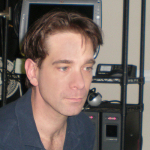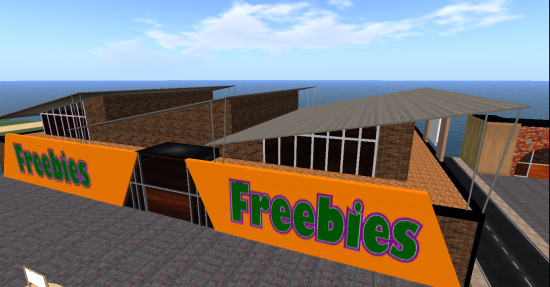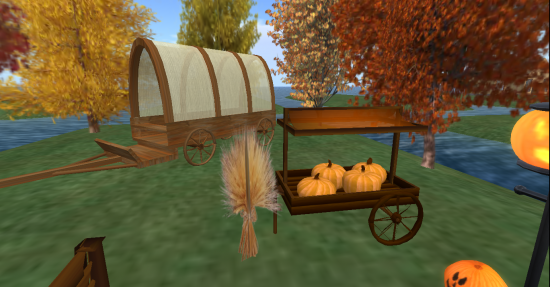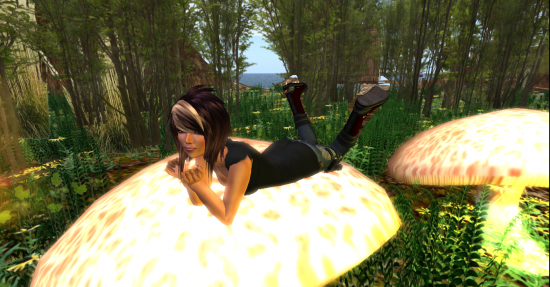This month, the Youth for Christ charity celebrates its second year in Second Life.
But the big party will be held in OpenSim, the charity’s new home.
The reason? The Second Life Teen Grid, where the YFC has been offering support and mentoring programs for at-risk youth, is closing at the end of the year. In fact, many teenagers have already abandoned the platform.
Price differential
Altogether, the organization was paying a total of around $300 a month for a region on the main grid and a region on the Teen Grid, said Christy Talbert, the director of YFC Online. On January 1, that would go up to $600 a month.
“They have priced us right out of the market,” said Talbert, who will shut down all Second Life regions when the amount already paid to Second Life runs out.
“We’ll just rent space when we need a meeting,” she said. “For us, it doesn’t make any sense to show up for that kind of money anymore. That was the last nail in the coffin for me.”
Instead, for the same money, YFC will move over to OpenSim, where the charity has just purchased a 20-region mini-grid from hosting provider ReactionGrid.
ReactionGrid is known for serving the education, non-profit and business sectors, and currently hosts more than 100 private grids for clients. It counts IBM and Microsoft among its customers, and has been featured in a Microsoft case study and in a Dell customer case study.
The YFC originally considered running the grid internally, on its own servers.
“But we decided we didn’t have the tech support to deal with that,” she said. ReactionGrid provides a management panel to handle many functions, such as restarting regions or making backups of the entire region in the form of OAR files. However, the company is also known for the support it provides to its customers.
“I really like them so far,” said Talbert. “They immediately respond to the questions I had. And I’m not much of a computer person, so I’m not the easiest person to work with. I’m more about the kids than about the computer!”
The initial setup was quick and easy, Talbert said, and the management panel also not difficult to use. “It’s very user-friendly, and that’s important to us.”
She also found OpenSim to be a pretty solid platform.
“If I leave my avatar up and come back in 24 hours, it’s still there,” she said. “So it’s much more stable than Second Life.”
The one major remaining concern is that of voice. The only option currently available in OpenSim is Freeswitch, which isn’t as good as the Vivox voice in Second Life.
“It cuts in and out,” Talbert said.
However, a new voice system, the Whisper-Mumble combination, is currently being tested and deployed in OpenSim, and is expected to be widely available later on this year. It’s been tested on a few other grids, and sounds as good as Second Life’s voice.
ReactionGrid is committed to finding a voice solution, Talbert added. “But we may have to use Skype for a while for our meetings.”
A 20-region mini-grid from ReactionGrid normally goes for $675 a month, with a $675 setup fee (product page here), but YFC got an additional discount, as well as some free technology upgrades.
“They did very well for us,” said Talbert. “The pricing was really reasonable, and that was important to us. I have to raise every penny that goes into this project.”
For example, ReactionGrid threw in a free starting avatar collection, which allows new users to pick from a selection of avatars when they first register on the grid.

ReactionGrid’s Custom Avatar Registration System normally sells for $500, but ReactionGrid CEO Kyle Gomboy told Hypergrid Business that non-profits and educators can get it for free. “We also offer to install third-party tools like OpenVCE for free.”
The grid prides itself on a fast and easy setup process.
“Our use of Hyper-v virtualization means we have an unlimited supply of virtual servers ready to start up,” said Gomboy. ” The longest part is collecting the default world sim names from the client.”
All told, the entire process of setting up a whole new grid takes about an hour, he said.
“No technical knowledge is needed from the client to setup or run a world,” he added. “We handle everything — unless they would like to learn themselves.”
YFC’s new grid is certified to support up to 65 simultaneous visitors, said Gomboy, though one customer has tested with 150 avatars connected at once. These avatars can be on a single region, or distributed across the grid.
The migration begins
About ten kids have already made the move over to the new grid, called YFC3D, and are helping the charity build facilities on the new grid.
In addition, YFC staffers and kids can bring in objects they have created on Second Life by using the Imprudence viewer. The charity won’t be able to move objects that they haven’t created themselves due to Second Life’s Terms of Service limitations. “Which is a bummer,” said Talbert. “We have many hundreds of dollars of content.”
She hasn’t yet begun contacting original creators to ask for export permissions. Some items — like animated animals — are hard to find in OpenSim and would be nice to have, she said.
She also added that she would be willing to pay a “reasonable markup” for content that she can take to her own grid, and hopes that a multi-grid marketplace will develop soon for OpenSim.

But though there is a lack of content in OpenSim — right now, at least — there are also some major advantages.
For example, with all the wide-open space the charity will now enjoy, it will be able to provide virtual homes and storefronts to the kids, said Talbert.
Hypergrid will be enabled, so kids from other grids, like OSGrid, will be able to come and participate in the programs. In addition, kids with accounts on YFC3d will be able to travel to other grids to visit freebie stores, to go shopping, to meet friends, or attend other events.
She said she wasn’t worried about griefers coming in from other grids and causing trouble.
“Honestly, I don’t think the kids on OSGrid are any worse than the kids on Teen Second Life,” she said.
And even if they are, the charity specializes in troubled teens, she added.
In informal surveys, about 75 percent of teens on the Second Life Teen Grid said they would be willing to follow YFC to OpenSim.
The YFC3D grid will have a PG rating, with no adult content allowed, said Talbert.

However, in many respects, there will be a lot more freedom than there was in Teen Second Life. Adults on the YFC3D grid will be able to give items to kids, give them ownership of land, and send instant messages to kids.
“[In Second Life] we had to come up with work-arounds for all of these — I’m anxious to get rid of all of those constraints,” Talbert said.
There will be a kick-off Halloween party at the end of October, and the grid will officially launch on November 1.
Basic services will be free for all visitors, but the grid is considering launching a paid membership in January, currently estimated at around $50 a year, that will give kids a permanent place to live on the grid. Until then, all homes will be free.
“We’re hoping to reduce the cost of our project a little bit, if we get some members,” she said.
She is also looking forward to being able to save regions. For example, in Second Life, the Halloween haunted prom environment needs to be set up by hand. In OpenSim, the entire region can be saved to be re-used later.
“And putting it up next October is as simple as pushing a button — that’s a huge time saver,” Talbert said.
The organization plans to collect a library of region backup files — called OARs (for OpenSim Archive) — with different environments and activities. Reloading a previously saved OAR is a simple button on the Web management panel.
The YFC also plans to create its own fictional currency for kids to use to buy and sell objects on the grid.
Donations welcome
The YFC3D grid is currently looking for donated content, including PG-rated objects, skins and animations. “We would like a reasonable amount of content when we open up,” said Talbert.
She’s particularly interested in getting games, animations and activities that the kids can engage in, as well as Halloween-themed content.
Those wishing to send her a donation can email her an XML file export from Imprudence, or simply hypergrid teleport to the YFC3D grid and give her the content.
For more information, or to donate virtual supplies, contact Talbert at sunburybuckeye@gmail.com.
About YFC
YFC’s virtual world project is run by the Central Ohio Youth for Christ chapter. YFC has a total of 200 chapters in the U.S., and is present in 90 different countries around the world.
But the Central Ohio chapter is one of the largest, and one of the most technologically innovative.
“Our motto at YFC is to go where the kids are,” said Talbert. “If they’re online, we’re online.”
The virtual chapter serves kids from Ohio, as well as from around the world. They find the program by accident, or by mistake, or get introduced by a friend.

“This is really a ministry to whatever kids happen to find this space,” she said. “We have kids who stay up until 3 .m. in the morning in the U.K., or in Switzerland, or whereever they are, so they can come to club meetings and participate.”
Young people of all faiths, including atheists, are welcome to participate as long as they are respectful of other participants’ beliefs, said Talbert. “You’re allowed to talk about your views, we’re open to any belief system. If they want to come, we’re open.”
Offline, the chapter goes where the kids are as well — to the worst neighborhoods of Columbus, Ohio, and to the juvenile detention centers. The chapter offers Bible study and spiritual programming, but goes far beyond that, with summer camps, tutoring programs, GED preparation, vocational training, anger management and relationship counseling, and other services.
Talbert first learned about Second Life in early 2008, and bought a couple of islands on the Teen Grid in August. By October, the YFC was conducting virtual club meetings on the space.
Since then, 1,200 kids have come to the Sunday night club meetings, many of them coming back again and again.

“Our program there was more successful than we had envisioned,” she said. “Our area is one of the top three areas on Teen Second Life, with lots of kids hanging around all the time.”
The limiting factor was that the sim couldn’t hold more than 37 visitors at once, Talbert said. “After that, everything starts to freeze up.”
YFC also conducts meetings on the Second Life main grid, targeting people aged 25 and under.
- International singers gather on Alternate Metaverse Grid for first annual International Day - April 15, 2024
- OpenSim hits new land, user highs - April 15, 2024
- Wolf Territories rolls out speech-to-text to help the hearing impaired - April 15, 2024
